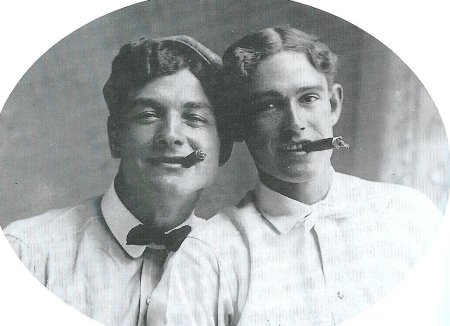
Friendships are an important part of a man’s life. Friends are those men you can count on when the chips are down. They’ll back you up even when the whole world is against you. Friends are those men who will buy you a beer (or a soda) when you lose a job or your lady dumps you. While the man friendship looks like a simple relationship, its history is actually quite interesting and complex. The virtues of duty and loyalty have remained the same guiding principles in man friendships throughout time. However, how men express those principles in a friendship has have gone through fascinating changes in the course of human history.
What follows is a brief history of the man friendship.
The Heroic Friendship
In ancient times, men viewed man friendships as the most fulfilling relationship a person could have. Friendships were seen as more noble than marital love with a woman because women were seen as inferior. Aristotle and other philosophers extolled the virtues of platonic relationships- a relationship of emotional connection without sexual intimacy. Platonic relationships, according to Aristotle, were the ideal.
During this period of time, the idea of the heroic friendship developed. The heroic friendship was a friendship between two men that was intense on an emotional and intellectual level. Examples of heroic friendships exist in many ancient texts from the Bible (David and Jonathan) to ancient Greek writings. A man friendship that captures the essence of the heroic friendship is the relationship between Achilles and Patroclus.
Achilles and Patroclus fought together during the Trojan War and had a close relationship. A really close relationship. When Hector killed Patroclus, Achilles was beside himself for days. He smeared his body in ash and fasted in lamentation. After the funeral, Achilles, filled with a mighty rage, took to the battlefield to avenge the death of his best friend.
The image of Achilles and Patroclus was an important one in the ancient world. When Alexander the Great and his war pal, Hephaestion, passed through Troy, they stopped, with the whole army in tow, in front of the tomb of Achilles and Patroclus, thus demonstrating the veneration they had for these men and their friendship.
Male Friendships in 19th Century America
Man friendships during the 19th century were marked by an intense bond and filled with deeply held feeling and sentimentality. Man friendships in many instances had a similar intensity as romantic relationships between men and women. Essentially, it was a continuation of the heroic friendship of the ancient world, coupled with the emphasis on emotion common to the Romantic Age. A fervent bond did not necessarily imply a sexual relationship; the idea that these ardent friendships in some way compromised a man’s heterosexuality is largely a modern conception.
Men during this time freely used endearing language with each other in daily interaction and letters. For example, Daniel Webster, an American senator and one of this country’s greatest orators, often began his letters to male friends with “My lovely boy,” and ended them with “Very affectionately yours.” Even letters by manly man Theodore Roosevelt to his friends were filled with sentimental language that would make most men today rather uncomfortable.
In addition to using affectionate language with each other, men during the 19th century weren’t afraid to be physically affectionate. Many men would give no thought to draping their arms around their bud or even holding hands. And while it is quite foreign to our modern sensibilities, it was even common during this era for men to share a bed to save money. For example, The Great Emancipator, Abraham Lincoln, shared a bed with a fellow named Joshua Speed for a number of years. Some scholars have concluded that this means Lincoln was gay. That’s where we get the term “Log Cabin Republican.” However most scholars conclude that there was no nookie going on between Abe and Joshua; they simply enjoyed a close and comfortable man friendship.
Take a look at these photos of man friends from the late 19th and early 20th Century. These guys were pretty touchy with each other. In fact, it was these photos that inspired me to write the post. During my weekly searches for vintage pics of men for the blog, I kept on coming across old photographs of men being really affectionate with one another. It’s pretty jarring to our modern man sensibilities:
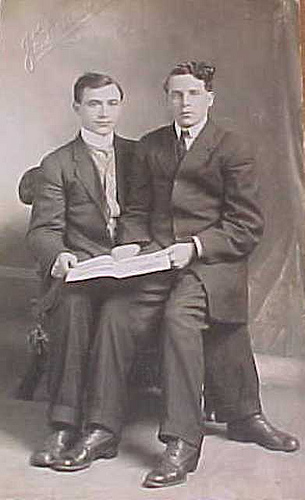
“You know, Alfred. There is another chair for you.”
“Shut up, Jedidiah.”
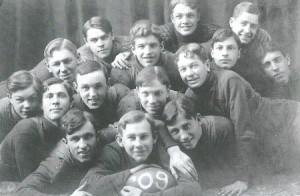
“Team picture!“
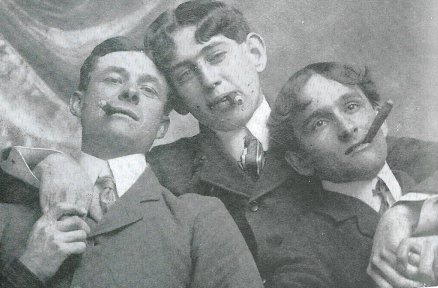
“Nothing like smoking cigars and holding hands with my bros.”

“Let’s express our man friendship in the most unnatural and awkward pose possible.”

“Come here you big lug!”

Jim looks down at Cliff with a jealous rage.
“Why does HE always get to hold Frasier and Ralph’s hands?”

Shooting big game and holding hands with my man friends.
Hemingway, eat your heart out, dude.
Some men see these photographs and wrongly conclude that these men were expressing their closeted gay tendencies for the camera. But this is not so. Actually, when you start sifting through old photos, you find that these kinds of poses were not abberations, but were actually quite commonplace. The photos open up a window into a picture of manliness quite foreign to us now.
There are several reasons why men were so damn affectionate with each other back in the day. First, men were free to have affectionate man relationships with each other without fear of being called a “queer” because the concept of homosexuality as we know it today didn’t exist then. America didn’t have the strict straight/gay dichotomy that currently exists. Affectionate feelings weren’t strictly labeled as sexual or platonic. There wasn’t even a name for homosexual sex; instead, it was referred to as “the crime that cannot be spoken.” It wasn’t until the turn of the 19th century that psychologists started analyzing homosexuality. When that happened, men in America started to become much more self-conscious about their relationships with their buds and traded the close embraces for a stiff pat on the back. The man hug was born.
Another reason for the nineteenth century’s intense man friendships was that the social structure of society during this time helped foster such intense bonds. Men and women basically lived in separate homosocial worlds until they got married. There wasn’t much interaction between the sexes at that time. (Interestingly, this is why amusement parks like those on Coney Island enjoyed such popularity in the early 1900’s; it was one of the few places men and women could mingle freely and even “accidentally” fall into each other’s arms on rides.). This separation led many young men to fulfill their needs for physical affection and emotional companionship with other dudes.
Additionally, fraternal organizations, ranging from the Freemasons to the Odd Fellows, were at their peak in membership in American history. Nearly 1/3 of all American men were members of some fraternal organization at the end of the 19th century. At their lodges, men would bond, connect, and help each other become better men.
Listen to my podcast with Stephen Mansfield about building your band of brothers:
Male Friendships in 20th Century America
The man friendship underwent some serious transformations during the 20th century. Men went from lavishing endearing words on each other and holding hands to avoiding too much emotional bonding or any sort of physical affections whatsoever. Fear of being called gay drove much of the transformation. Ministers and politicians decried homosexuality as being incompatible with true manhood. And like most deviant behavior in the 1950s, homosexuality was associated with Communism.
Additionally, market economics began to influence male friendships. The Industrial Revolution and ideas like Social Darwinism changed the way men viewed each other. Instead of being a potential friend, the man next to you was competition. The world was an urban jungle and the man who looked out for himself was the man who was going to eat. It’s hard to develop the cutthroat instinct needed to destroy the competition when the competition happens to be your bosom buddy.
Increased mobility during the 20th century also contributed the decline in man friendships. When you have to follow your work, it’s hard to set down roots and make true friends. And with the increased leisure time that came with industrialization, men began to play more sports and take part in outdoor activities. They naturally geared their relationships with other men around these sorts of pursuits. Suburbia created other places where men could establish man friendships- the golf course, the front yard, and work. Instead of basing friendships on an emotional bond, men in the 20th century based their friendship around activities.
The one area in modern man friendships where we still see strong emotional bonds is in the military. One of the reoccurring themes I read in stories about a man’s military life are the friendships that they established while in the service. Working in largely all-male teams in life and death situations creates intense bonds and a true brotherhood. Soldiers will never leave a man behind and are willing to die to protect their comrades. Interestingly, it would seem that the overt machismo of the military allows these strong bonds to exist without the fear of homophobia getting in the way. Here’s a particularly touching image of a man friendship among soldiers:
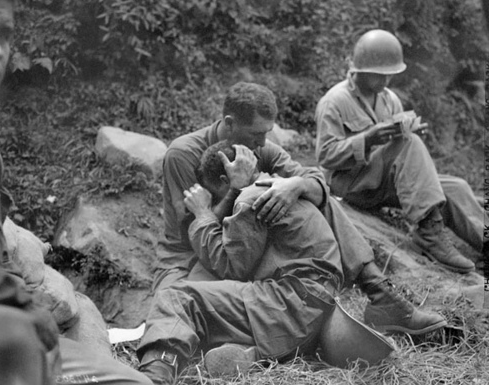
Several man groups have tried to help men more deeply connect with their feelings and with each other. Those movements have, for the most part, not been as successful as people thought they’d be. I think perhaps it is because the whole thing seemed too forced. Sure, today’s man enjoys close camaraderie with his pals; but he doesn’t want to be given cues or told when to get teary eyed and emotional.
What’s So Great About Man Friendships
Today, when a man is free to form close and intimate associations with females, he generally does not feel the need to cuddle with his bosom buddy and express his love.
Still, it’s a shame that our society’s rampant homophobia prevents men from connecting with each other on a more emotional and physical level. I’m not talking about crying and holding each others heads in our nooks. Hell no. And I can’t say I pine for the days of friendly bed-sharing. But men, particularly American men, are often missing out on the benefits of close man friendships. Studies reveal that men who have several close friends are generally happier and live longer than men who don’t. And yet research shows the number of friends and confidantes a man has to be steadily dropping, leading to greater isolation and loneliness. Once you leave college, and especially once you get married and have kids, it becomes pretty difficult to make and keep friends. But the effort is worth it.
In talking to my wife about the differences between man friendships and female friendships, she helped me flesh out several of the admirable qualities of friendship between dudes:
True loyalty. A lot of my female friends will complain about one or more of their boyfriend’s or husband’s friends. The disliked friend will usually be a guy the husband/boyfriend has known since high school or even longer. The woman will be baffled as to why her husband or boyfriend is still friends with this character when on the surface they no longer have much in common. These women miss the nature of man friendships; it’s all about loyalty.
Non-judgmental. Dudes really aren’t very sensitive or critical of each other. Several times at the gym I have seen a really fit guy helping his fat friend get in shape. But I’ve never seen this dynamic among women. A guy can say, “Hey man, do you need help with that? Let’s work on it together,” without the man getting offended and saying something like, “What? You think I’m fat? I can’t believe you think I’m fat!”
Straightforward. When a guy is bothered by something that his friend is doing, he simply tells his friend, they discuss it, sometimes heatedly, and then move on. A man generally does not keep burning angst bottled up inside, waiting to explode. And when men no longer get along, they most often simply go their separate ways without much muss or fuss. Not so, for a lot of the female friendships I have seen (not all ladies, not all!). A lot of women, and sorry ladies, it’s true, are down right cruel to each other. They not only part ways, but engage in emotional warfare designed to crush each other’s spirit. Guys keep things pretty straightforward; we like each other, cool, we no longer get along, see ya.
It has been said that female friendships can be pictured as two women facing one another, while male friendships can be symbolized as two men standing side by size, looking outwards. So here’s to having a buddy, a brother to take on the world with. Long live man friendship.
Sources:
John Isbon, Picturing Men: A Century of Male Relationships in Everyday American Photography (University of Chicago Press, 2006)
E. Anthony Rotundo, American Manhood: Transformations in Masculinity From the Revolution to the Modern Era (Basic Books, 1994).
Tags: Friendship

